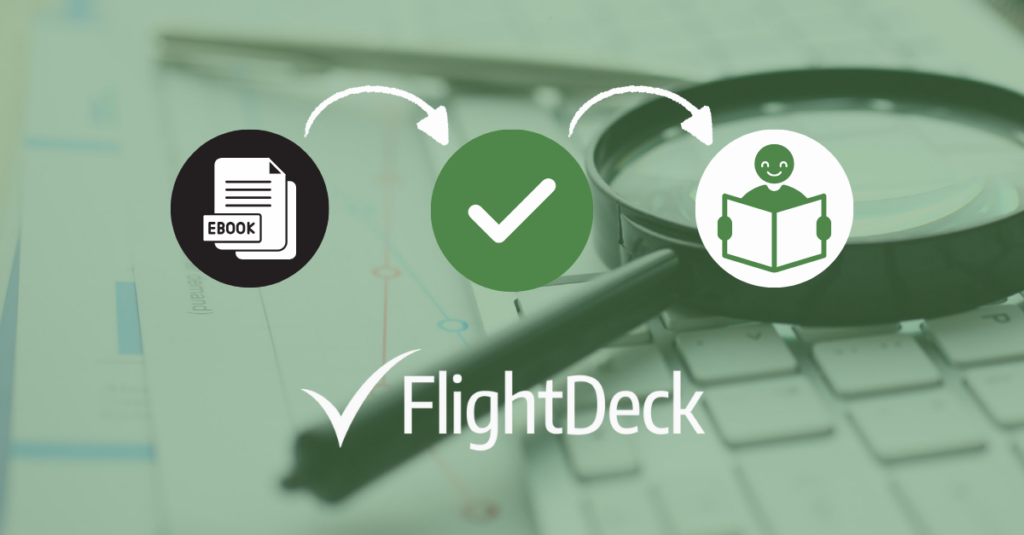
8 Steps to Double-Check Before Uploading EPUBs
Avoid retailer rejections, formatting fails, and unhappy readers with this essential QA checklist for publishers.
Uploading an EPUB file might feel like the final step in your publishing process—but skipping quality checks can lead to a number of unexpected issues. That’s where FlightDeck comes in. As the most advanced EPUB validation and testing tool available, FlightDeck helps you catch and fix issues early with clear, actionable guidance.
Here are 8 things every publisher should double-check before uploading an EPUB file for distribution:
1. Test on Real Devices
Don’t rely on your desktop preview alone. It’s recommended to test your EPUB file for all of the retailers you will be targeting and scroll through your entire ebook on at least one device. Look for:
- Misplaced or missing content (especially images and sidebars)
- Inconsistent page breaks, font size, and other formatting issues
- Night/sepia mode display glitches
Remember, real-device testing often reveals what software previews won’t.
2. Review Metadata Carefully
Your EPUB’s metadata should match your book’s cover and title page exactly. At a minimum, include:
- Title, author, ISBN, and language
- Option extras: publication date, contributors, rights, BISACs, and keywords
✅ FlightDeck tip: All of this information can be edited directly in FlightDeck’s Metadata Editor.
3. Check All Links
Broken links = poor user experience. Run a full link test to double-check that:
- External URLs are live
- Internal links (like chapters, notes, or figures) work properly
- TOC items point to the correct sections—non just the top of the page
✅ FlightDeck tip: FlightDeck provides you with a list of all of the file’s internal links, making it easy to check them without having to open each one in the ebook itself, and will also flag some potential link issues, saving you time and guesswork.
4. Use Fonts Wisely
Most retailers discourage embedding fonts for body text. Instead:
- Use embedded fonts only for special styling
- Test with “Publisher Defaults” turned off
- Avoid fonts that appear blurry or distorted on smaller screens
- Check readability on both E Ink and LCD screens
✅ FlightDeck tip: FlightDeck will provide validation errors related to embedded fonts, and also provides a list of the embedded fonts for easy confirmation.
5. Optimize Images & Media
A good ebook balances image clarity with performance. Best practices:
- Cover image should include both title & author, without print-specific information
- Use 300ppi images (or better) under 10MB per image
- Save in RGB, not CMYK
- Scale with CSS, not HTML
- Test visibility in night, grayscale, and sepia modes
For video or audio:
- EPUB 3 is recommended
- Stay under file size limits (generally under 500MB)
- Make sure media includes fallback options (e.g., a transcript or still image)
✅ FlightDeck tip: FlightDeck helps flag oversized images and potential format conflicts for multimedia files.
6. Check Navigation Structure
Readers rely on effective navigation to move through your book. Before uploading:
- Update your TOC if you’ve moved front matter to the back (such as copyright, forewords, etc)
- Make sure footnotes and references link in both directions
- Add a PageList for page numbers, if used
✅ FlightDeck tip: Publishers can validate their TOC structure with FlightDeck and ensure that navigation works smoothly.
7. Validate Special Characters
Publishers should be especially cautious when using custom fonts. Things to look for:
- All text should use Unicode characters—other fonts may incur errors, such as “a” displaying as “א”
- Special characters / foreign language should always appear in the default system fonts. This can usually be checked by turning off “Publisher Defaults” or changing the default font in the reading system settings.
✅ FlightDeck tip: FlightDeck also flags encoding errors and some common ligatures that may cause reader complaints.
8. Simplify Complex Content
Tables, forms, and charts don’t always convert well to digital. To avoid problems:
- Use HTML-coded tables, not images—and test how they appear on smaller screens
- Replace interactive forms (e.g., quizzes, worksheets) with PDFs that are available for download on the book’s product page on your website
- Add descriptions to color-coded charts to support accessibility
FlightDeck is your EPUB QA partner.
From metadata validation to layout checks and link verification, FlightDeck helps publishers catch issues before retailers—or readers—ever see them. Don’t leave your ebook launch to chance!
Sign Up for FlightDeck today to validate EPUB files with confidence.
